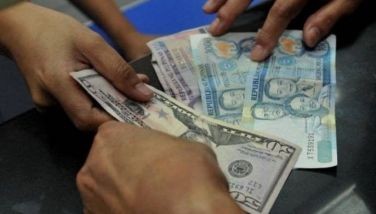Scaling down

In the face of growing pessimism over the gargantuan hurdles that a third telecommunications company in the Philippines will have to surmount to fulfill the requirements laid out by the Department of Information and Communications Technology (DICT), a scaling down in operations is imminent.
The DICT had earlier released its thoughts on the criteria for selecting a third telco player to challenge the duopoly of Smart and Globe, both industry players sharing about half each of the current mobile services market in the country, and interested companies have not been too enthusiastic.
Even with the original requirement of a P10-billion capital threshold scrapped, other conditions are still deemed to be tough in view of stipulated commitments over the first five years of operations.
The DICT wants the third telco player to cover at least 80 percent of provincial capital cities and towns, and 80 percent of chartered cities within five years. Presumably, the capital needed for expansion is without regard to whether the telco is earning enough revenues year after year.
The capitalization for the five-year plan, estimated at a minimum of P300 billion, would be a bit too much for a local company to shoulder alone, and the resources of an established foreign telco would be ideal, except that the math does not look good.
When the foreign white knight with the money and technical expertise is confined to only 40 percent of the consortium with local partners, the returns on investment are not at all appealing – unless there are other non-monetary considerations that come into the bargaining.
Chinese connection
This could very well be why, as my source says, China Telecommunications in partnership with Huawei, reputedly the world’s biggest manufacturer of telecommunications equipment, cannot be ruled out despite their seeming absence in current discussions.
China Telecom and Huawei are partners in many of China’s densely populated districts in bringing better internet connectivity to Chinese offices and homes. Huawei’s close ties with the Chinese government are largely credited to Huawei’s founder, a former engineer of the Chinese Liberation Army.
Wikipedia says Huawei “gained a key contract to build the first national telecommunications network for the People’s Liberation Army, a deal one employee described as ‘small in terms of our overall business, but large in terms of our relationships.’
“In 1994, founder Ren Zhengfei had a meeting with Party General Secretary Jiang Zemin, telling him that ‘switching equipment technology was related to international security, and that a nation that did not have its own switching equipment was like one that lacked its own military.’ Jiang reportedly agreed with this assessment.”
Ominous as it may sound, should China Telecom with Huawei take the plunge and submit a bid next month, it will be the first real big investment by China in the Philippines, and one that could be a popular move, especially if telecommunication services in the Philippines significantly improve.
Insignificant investments
In 2016, after President Duterte’s first official visit to Beijing, some $24 billion in investment and trade pledges by the Chinese were announced. Unfortunately, nothing much has materialized despite a concessionary shift by the Philippine government in many controversial issues with China, including the militarization of the South China Sea.
In fact, Chinese investments in the Philippines continue to come in trickles, with the most obvious positive contributions to the Philippine economy being the increase of inbound tourists from the mainland and the rise in exports of Philippine-made products, which has dented even minimally the trade imbalance between the two countries.
Japan, the US and the EU continue to be the top investment sources for the Philippines, with Japan significantly contributing to boosting the Duterte government’s Build Build Build program through a number of big-ticket infrastructure projects.
The smattering of Chinese investments to the Philippines, so far, have been confined to casinos, real estate, tourism and mining. There has been promise of donating two bridges and financing of 10 more bridges in Metro Manila worth about P28 billion in a “second basket” of projects, but nothing much has been firmed up.
The “first basket,” on the other hand, will be expected to finally advance with the signing of loan agreements sometime in the middle of the year. This will include the P10.9-billion Kaliwa Dam, the P2.7-billion Chico River pump irrigation, and the P151-billion PNR South railway.
Toss into this basket the third telco project, that is, if the Chinese will really go for it.
Nagging question
Meanwhile, the nagging question persists: Will we really see better telecommunication services with a third telco? Considering the archipelagic characteristic of the Philippines and the bemoaned red tape in building cell sites, which are integral in expanding and improving connectivity, the third telco player will have its hands full trying to grow and earn.
Industry experts have been saying the market needs to be deregulated further, in particular, accepting unrestricted foreign investments in the industry. This means retooling the Public Telecommunications Policy Act, which has been criticized as being outmoded.
The bandwidth allocation for a third telco is also seen to be inadequate, with the duopoly already owning the best; as such, this would be the biggest roadblock for it to effectively compete against the industry duopoly.
Still, we hope President Duterte knows what he’s doing – and even if we did not see a third telco last March as the President had earlier demanded, the promise of better connectivity may be closer to becoming a reality – if the Chinese play ball.
Facebook and Twitter
We are actively using two social networking websites to reach out more often and even interact with and engage our readers, friends and colleagues in the various areas of interest that I tackle in my column. Please like us at www.facebook.com and follow us at www.twitter.com/ReyGamboa.
Should you wish to share any insights, write me at Link Edge, 25th Floor, 139 Corporate Center, Valero Street, Salcedo Village, 1227 Makati City. Or e-mail me at [email protected]. For a compilation of previous articles, visit www.BizlinksPhilippines.net.
- Latest
- Trending































